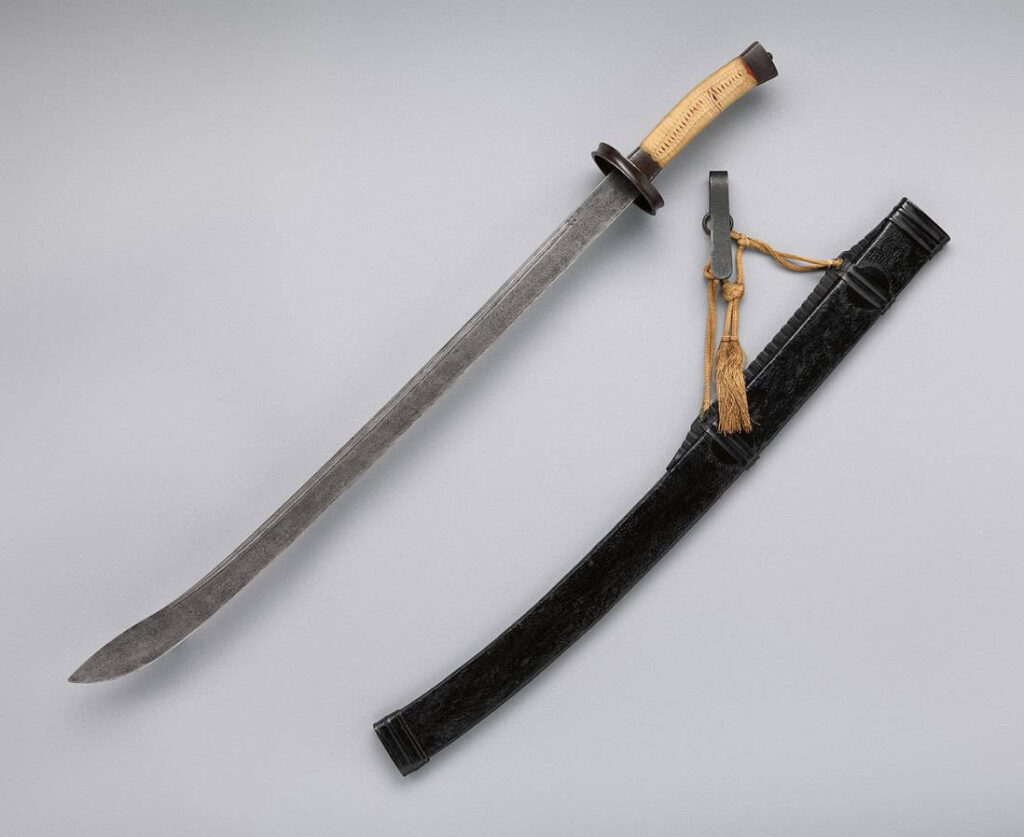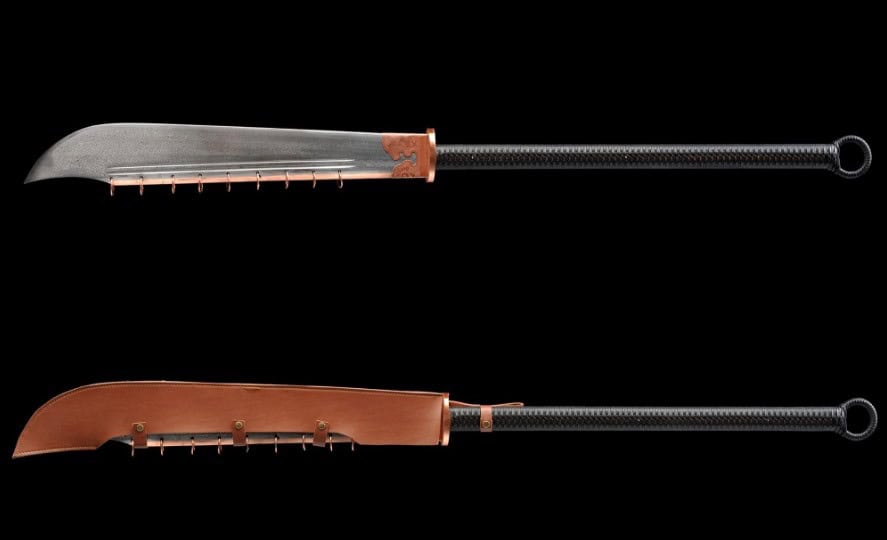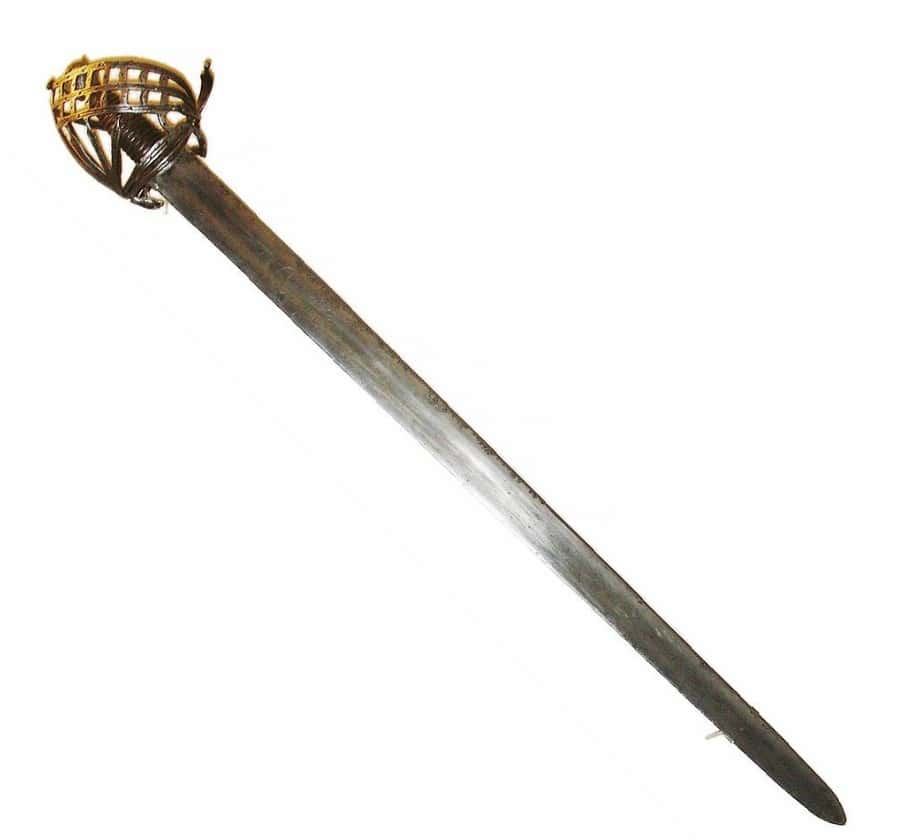The Broadsword: Chinese, European, and Highland Variants
TLDR: A broadsword is a versatile, wide-bladed weapon used historically across various cultures, including Europe and China, characterized by its ability to deliver powerful cutting strikes and its significant role in shaping martial techniques and cultural identities.
The broadsword, a powerful weapon across cultures, showcases human ingenuity in warfare and martial arts. With its wide, straight blade, it evolved differently worldwide, reflecting each culture’s unique needs and traditions. From medieval Europe’s battlefields to ancient China’s training grounds, the broadsword shaped combat techniques and military strategies. Beyond function, it embodies the cultural values and martial philosophies of its societies.
In this exploration, we’ll dive into various broadsword types, their origins, and cultural significance. We’ll compare the Chinese broadsword with European versions, explore the 9 Ring broadsword, and trace German fencing techniques.
Finally, we’ll journey to Scotland, where the broadsword symbolizes Highland warrior culture. Understanding these broadsword variations offers insights into the evolution of weaponry and the historical and cultural contexts that shaped these blades.
The Chinese Broadsword
The Chinese broadsword, known as the dao, has a rich history dating back to ancient times. Originally developed during the Zhou Dynasty (1046-256 BCE), the dao evolved from earlier bronze weapons and became a prominent military sword during the Ming and Qing dynasties.
The dao is characterized by its single-edged blade, which is typically heavier and more curved than earlier straight Chinese swords. This design makes it ideal for slashing and chopping motions.
The blade usually ranges from 70 to 110 cm in length, with a thick spine that adds weight and power to each strike. One distinctive variant that emerged in the mid-19th century is the “oxtail dao” or “niuweidao,” recognizable by its flaring blade towards the tip. Culturally, the dao holds significant importance in Chinese martial arts and society.
During the Ming and Qing dynasties, it became a symbol of military prowess and personal defense. The dao’s versatility and effectiveness in combat led to its widespread adoption among soldiers and civilians alike. In Chinese martial arts, the dao plays a central role in many styles and forms.
It is often referred to as the “Chinese broadsword” in kung fu schools and films, although this term is not historically accurate. The dao’s use in martial arts emphasizes powerful cutting techniques, fluid movements, and intricate footwork. One notable variant in martial arts is the “butterfly sword” or “hudiedao,” a short dao often used in pairs in southern Chinese martial arts styles.
These compact weapons allowed for easy concealment and quick deployment in close-quarters combat. The dao’s influence extends beyond practical combat applications. It has become an integral part of Chinese cultural heritage, featured prominently in traditional performances, historical reenactments, and modern wushu competitions. The weapon’s graceful yet powerful movements embody the balance between strength and finesse that is highly valued in Chinese martial philosophy.
Broadsword vs. Longsword: Key Differences
The broadsword and longsword, while both significant European swords, differ considerably in their design, usage, and historical context.
| Broadsword | Longsword | |
| Design | The broadsword features a wider, heavier blade designed primarily for cutting. It includes a basket hilt for hand protection. | The longsword has a longer, slender blade with a sharp point, allowing for cutting and thrusting. It has a cruciform hilt and prominent pommel for two-handed use. |
| Usage | Emphasizes powerful slashing movements ideal for close combat and rugged terrain battles. | Accommodates a broad range of techniques, including powerful strikes and complex maneuvers integrating cutting and thrusting. Effective in duels and on battlefields. |
| Historical Context | Prominent in the 16th and 17th centuries, favored by Scottish and English warriors for military conflicts and civilian defense. | Staple of medieval Europe from the late Middle Ages through the Renaissance. Used by knights and men-at-arms in warfare and chivalric combat. |
| Cultural Significance | Symbol of resistance and national pride in Scottish culture, associated with the fight for freedom against English invasion. | Represents medieval knightly ideals of chivalry and valor, celebrated for martial effectiveness and noble virtues. |
| Modern Relevance | Taught in traditional Scottish martial arts and used in ceremonial displays. | Practiced in Historical European Martial Arts (HEMA) competitions, where ancient techniques are rediscovered and replicated. |
The European Broadsword
The European broadsword emerged as a distinct weapon type in the late medieval period, evolving from earlier sword designs to meet the changing demands of warfare and personal combat.
Development and Variations:
The broadsword’s development can be traced back to the 13th century, with its design refining over the following centuries. It was characterized by a wide, straight, double-edged blade, typically ranging from 70 to 110 cm in length. The most distinctive feature of the European broadsword was its basket hilt, which provided extensive protection for the wielder’s hand.
Variations of the broadsword emerged across different regions of Europe:
- Scottish Broadsword: Featuring a distinctive basket hilt, often with intricate designs and sometimes incorporating St. Andrew’s crosses.
- Mortuary Sword: An English variant with a hilt resembling a human rib cage, often decorated with portrait medallions or chiseled heads.
- Venetian Schiavona: Characterized by a leaf-shaped basket guard and a cat’s head pommel, used by Slavonic troops serving the Venetian Republic.
- German Broadswords: Often equipped with complex hilt designs, influenced by the Landsknecht swords.
Influence on Medieval Combat and Warfare:
The broadsword’s impact on medieval combat and warfare was significant:
Versatility: Its design allowed for both cutting and thrusting techniques, making it effective in various combat scenarios.
- Hand Protection: The basket hilt provided superior protection, allowing warriors to engage in close-quarters combat with reduced risk of hand injury.
- Military Adoption: Broadswords became widely used by European militaries, particularly cavalry units, from the late 1600s to the early 1900s.
- Civilian Defense: Beyond military use, broadswords were also popular for personal protection during tumultuous times.
- Cultural Significance: In some regions, like Scotland, the broadsword became a symbol of national identity and resistance.
- Evolution of Fencing: The broadsword played a role in the development of European martial arts, influencing fencing techniques and combat styles.
The broadsword’s legacy continues to this day, with modern Historical European Martial Arts (HEMA) practitioners studying and recreating historical broadsword techniques. Competitions and championships, such as the World Broadsword Championship revived in 2015, keep the tradition of broadsword fencing alive
The 9-Ring Broadsword
The 9 Ring Broadsword, also known as the Nine Ring Dao, is a unique and intriguing variant of the Chinese broadsword that has captured the imagination of martial artists and enthusiasts alike.
Unique Features:
The most distinctive feature of this sword is the presence of nine metal rings attached to the spine of the blade. These rings are typically loose and can move freely, producing a jingling sound when the sword is wielded. The blade is usually made of rigid aluminum for practice purposes, with a standard length similar to other Chinese broadswords.
Symbolic Meanings:
The number nine holds significant symbolic value in Chinese culture, often associated with longevity, completeness, and imperial authority. While the exact symbolism of the nine rings is subject to interpretation, some theories suggest:
- Distraction: The sound of the rings may have been used to confuse or intimidate opponents.
- Animal deterrent: The noise could potentially scare away wild animals.
- Weapon hooking: The rings might have been used to catch or hook other weapons.
- Ceremonial purposes: The distinctive sound could have been utilized in demonstrations or rituals.
Role in Chinese Martial Traditions:
The 9-Ring Broadsword holds a unique place in Chinese martial arts, though its historical authenticity and widespread use are subjects of debate:
- Rarity: It is considered one of the rarer swords in Chinese Kung Fu, with few practitioners familiar with its forms.
- Training tool: The weight and sound of the rings provide feedback to practitioners, helping them assess the quality of their strikes and movements.
- Skill demonstration: The complexity of handling a sword with moving rings may have been used to showcase advanced martial prowess.
- Modern practice: While historical references are scarce, the 9 Ring Broadsword is still used in some traditional kung fu styles for forms practice and demonstrations.
It’s important to note that while the 9 Ring Broadsword is popular among martial arts enthusiasts, its historical authenticity as a combat weapon is not well-established. Some experts suggest it may be a more recent innovation or a specialized training tool rather than a widely used battlefield weapon.
The German Broadsword
The German broadsword, while not as distinctively national as its Scottish counterpart, played a significant role in the evolution of European swordsmanship. Its development can be traced back to the late medieval period, with refinements continuing through the Renaissance and early modern era.
In the 16th and 17th centuries, the city of Solingen emerged as a major center for sword production in Germany. Solingen blades were renowned for their quality and were often exported to other European countries, including Scotland, where they were fitted with locally-made basket hilts.
The German broadsword evolved alongside the broader European sword traditions, incorporating elements from medieval longsword techniques while adapting to changing battlefield requirements and dueling practices.
Fencing Techniques:
German broadsword techniques were influenced by earlier longsword traditions, particularly those stemming from Johannes Liechtenauer’s school of fencing. Key aspects of German broadsword fencing included:
- Emphasis on both cutting and thrusting techniques.
- Use of guards (or stances) derived from earlier longsword traditions.
- Integration of grappling and wrestling techniques, known as Ringen.
- Adaptation of techniques for both unarmored and armored combat.
The German school of fencing, which included broadsword techniques, placed a strong emphasis on footwork and body mechanics. However, complex footwork was often seen as impractical in real combat situations.
Contributions to European Martial Arts:
The German broadsword tradition made several significant contributions to European martial arts:
- Influence on Bayonet Fencing: German broadsword techniques significantly influenced the development of bayonet fencing in the 16th and 17th centuries. Many bayonet fencing systems drew directly from longsword and broadsword techniques.
- Preservation of Medieval Techniques: German fencing masters like Joachim Meyer helped preserve and adapt medieval longsword techniques for use with the broadsword, ensuring the continuity of these martial traditions.
- Development of Comprehensive Systems: German fencing treatises often covered a wide range of weapons and techniques, contributing to the development of holistic martial arts systems.
- Influence on Military Training: German broadsword techniques were incorporated into military training manuals and influenced cavalry swordsmanship across Europe.
Legacy in Historical European Martial Arts (HEMA): The detailed treatises left by German fencing masters have been crucial in the modern reconstruction of historical fencing techniques, contributing significantly to the HEMA movement.
The Highland Broadsword
The Highland broadsword, also known as the basket-hilted broadsword, became an iconic weapon of Scottish warriors, particularly in the 17th and 18th centuries. Its distinctive basket hilt, which provided excellent hand protection, made it well-suited for the fierce close-quarters combat favored by Highland clans.
The broadsword’s effectiveness in battle was legendary. During the Jacobite risings, Highland warriors wielding these swords struck fear into their opponents. Historical accounts describe the devastating impact of their swordsmanship, with one 1840 report detailing how Highlanders at the Battle of Killiecrankie (1689) inflicted horrific wounds, cutting through skulls and severing limbs with powerful strokes.
The weapon’s versatility made it equally effective for both cutting and thrusting techniques. This adaptability, combined with the Highlanders’ aggressive fighting style, made the broadsword a formidable weapon on the battlefield.
Cultural Symbolism and Legacy:
The Highlander broadsword became more than just a weapon; it evolved into a potent symbol of Scottish identity and resistance. During times of conflict with England, the broadsword represented Highland pride and the fight for independence.
Even after the decline of clan warfare, the broadsword retained its cultural significance. It became an integral part of Highland dress and ceremonial attire. The tradition of wearing a basket-hilted broadsword as part of formal Highland wear continues to this day, especially at events like weddings and formal gatherings.
The legacy of the Highlander broadsword extended beyond Scotland as Highland regiments were incorporated into the British Army. These regiments, known for their fierce fighting spirit, carried their broadswords into battles across the expanding British Empire, from the Americas to India.
In modern times, the Highlander broadsword remains an important cultural artifact. It features prominently in historical reenactments, Highland games, and martial arts practices focused on preserving traditional Scottish fighting techniques. The weapon’s design has also influenced modern military swords, with some ceremonial swords of Scottish regiments still incorporating elements of the traditional basket hilt.
Where Can I Get My Own Broadsword?
For those interested in acquiring a broadsword, there are numerous options available both online and in specialized stores. When selecting a broadsword, consider the historical accuracy, quality of materials, and the intended use—whether for display, martial arts practice, or reenactments.
Hanbon Forge

What I Like:
- Material and Craftsmanship: The Chinese Qilin Dao Sword features a Damascus folded steel blade with a beautiful grain pattern (HADA) and visible layers, treated with heat and oil quenching, and polished by hand.
- Design and Aesthetics: The sword comes with a black ebony sheath and handle, adorned with pure brass fittings showcasing intricate Qilin designs and patterns.
- Dimensions and Weight: The sword has an overall length of 81 cm, with a 49 cm blade, 25 cm handle, and weighs 0.92 kg without the scabbard and 1.55 kg with the scabbard.
Kult of Athena
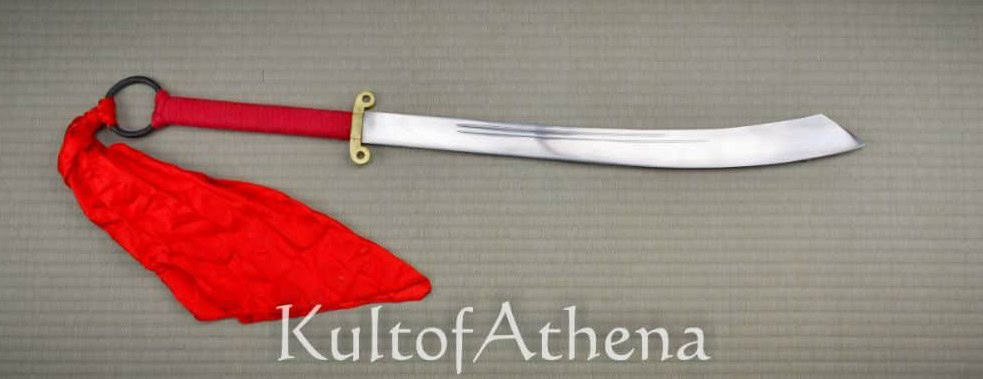
What I Like:
- Versatile Usage: The Military Da Dao features a powerful chopping blade and a grip suitable for one or two-handed use, making it effective for both combat and practical tasks like clearing brush.
- Durable Construction: Crafted from GB 60Si2MnA High Carbon Manganese Spring Steel, the blade is well-tempered to 56-58 HRc with a thick spine for enhanced durability and striking power.
- Quality Design: The sword includes a brass guard, iron pommel ring, and a wooden grip wrapped in red cord, along with a stitched leather sheath for storage.
Swords of Northshire
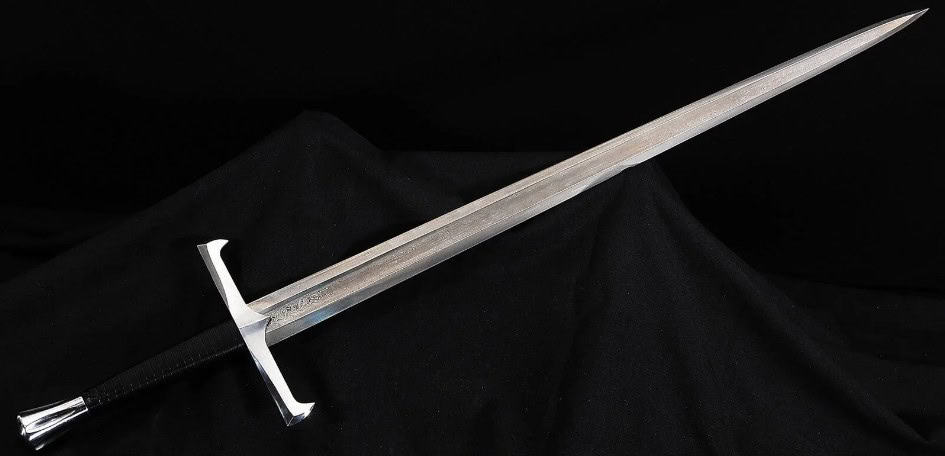
What I Like:
- Durable Blade: The broadsword features a hand-forged, folded 1095 high carbon steel blade with a visible grain pattern and a traditional 13-stage hand-polished finish.
- Quality Handle: The handle is made of hardwood, wrapped in black leather cord, and fitted with a sleek iron handguard and pommel.
- Battle Ready: This full-tang sword is solidly built and capable of cutting through thick bamboo, bone, and iron wire, making it battle-ready.
Medieval Collectibles
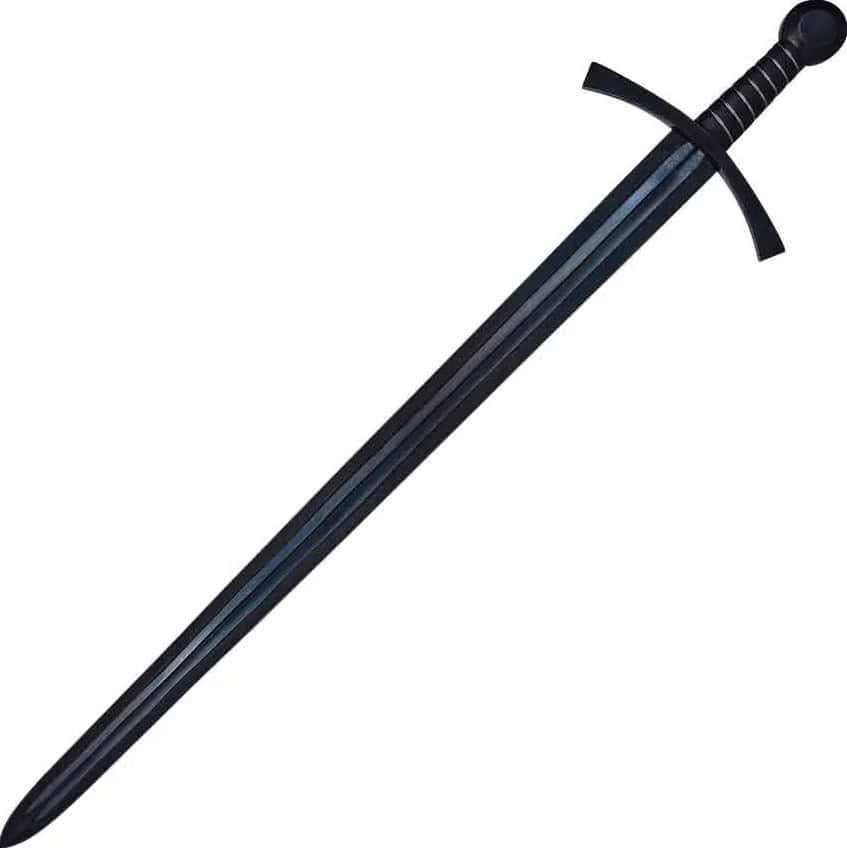
What I Like:
- Expert Craftsmanship: The Acre Broadsword is hand-forged by experienced smiths using tough 1065 high carbon steel, ensuring durability and quality.
- Superior Blade: The blade is tempered to an RC in the low 50s for strength, resiliency, and edge retention, and comes expertly sharpened with a full tang design.
- Distinctive Finish: The sword features a stonewashed black finish and includes a matching scabbard for a stunning medieval look.
Etsy – Leopardcollector

FAQs
What is the difference between a broadsword and other sword types?
A broadsword has a wide, straight, double-edged blade and a basket hilt. It’s different from the thinner rapier, which is great for thrusting, the curved saber with one edge, the longer two-handed longsword, and the simpler arming sword with a crossguard hilt. Popular in Scotland during the 17th and 18th centuries, the broadsword was versatile, perfect for both cutting and thrusting, making it a solid choice in many fights.
How protective are broadsword hilts?
Broadsword hilts, especially the basket-hilted ones, provide great hand protection by wrapping around the hand and blocking cuts from different angles. Flat ribbon-style baskets might need maintenance since they can get bent during use, while solid bar designs are tougher but heavier. Protection levels vary between styles like Scottish and English, each offering different benefits in protection and handling.
What fighting techniques were used with broadswords?
Broadsword fighting was pretty diverse and sophisticated, combining cutting and thrusting moves. Fighters would parry with both the blade and the basket hilt, and often used their off-hand for grappling or holding a targe (shield). These techniques came from Highland Broadsword, a Scottish martial art, and had similarities to side sword or military saber techniques. Historical manuals by folks like Donald McBane and Thomas Page give great insights into how effective and complex broadsword combat was back then.
How does the weight and balance of a broadsword compare to other swords?
Broadswords usually weigh between 2-3 pounds (0.9-1.4 kg) and are balanced closer to the handle, which makes them more agile despite their wide blades. This design helps with quick movements and better control in combat. Some modern replicas, however, are criticized for being too heavy or “clunky,” not really like the originals. Manufacturers like Hanwei and Arms & Armor have been working to make their broadswords more historically accurate, improving how they handle.
What are the differences between various broadsword hilt designs?
Broadsword hilt designs can really differ, offering various levels of protection, style, and handling. The diamond pattern looks cool and offers good protection. The Stirling pattern, named after Stirling Castle, has S-shaped bars. The Glasgow pattern is more open with larger gaps between the bars. Cup and ring designs provide great protection but can be heavier. These options let people pick a hilt that matched their fighting style and personal preference.
How does the Scottish basket-hilted broadsword relate to Renaissance-era swords?
The Scottish basket-hilted broadsword comes after the Renaissance swords. It evolved from earlier cut-and-thrust swords and is similar to side swords and early sabers. However, it has a more advanced hilt design than most Renaissance swords and was most popular in the 17th-18th centuries, making it a post-Renaissance weapon. This change shows how warfare and personal combat needs evolved over time.
What blade types are available for modern broadsword reproductions?
Modern broadsword replicas come with a range of blade types for different tastes and uses. You can find traditional broad, double-edged blades, and “Manitoba blades” for better historical accuracy in weight and balance. Some blades are stiffer for cutting, while others are more flexible for thrusting. You can also pick different blade lengths based on your fighting style or personal preference, plus various steel types and hardness levels to fit your needs and budget.
How does the broadsword compare to the Scottish claymore?
Both these Scottish swords are distinct in style and purpose. The broadsword is a one-handed weapon with a basket hilt and a blade around 30-36 inches long, popular from the 17th to 18th centuries. On the other hand, the claymore is a hefty two-handed sword with a cross hilt, over 55 inches in total length, mainly used from the 15th to 17th centuries.
The broadsword was more versatile, serving both civilians and soldiers, while the claymore was mainly a battlefield weapon. It’s important to note that the term “claymore” can be confusing because it’s sometimes wrongly used to describe basket-hilted broadswords in modern times.
Conclusion
Exploring the broadsword has been an incredible journey through history and martial arts. Each sword, from Europe’s robust blades to China’s elegant dao, tells a fascinating story of craftsmanship and cultural values.
Personally, I find the Highland broadsword particularly captivating. Its design and the fierce spirit of its wielders during Scotland’s turbulent times resonate deeply with me. It symbolizes not just martial prowess but also a powerful sense of identity and resilience against adversity.
Studying these swords has been more than just understanding their physical attributes; it’s delving into the rich tapestry of human creativity and the diverse paths that shaped these iconic weapons.

